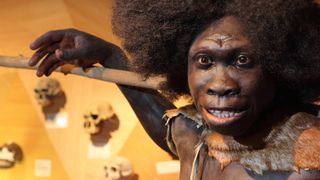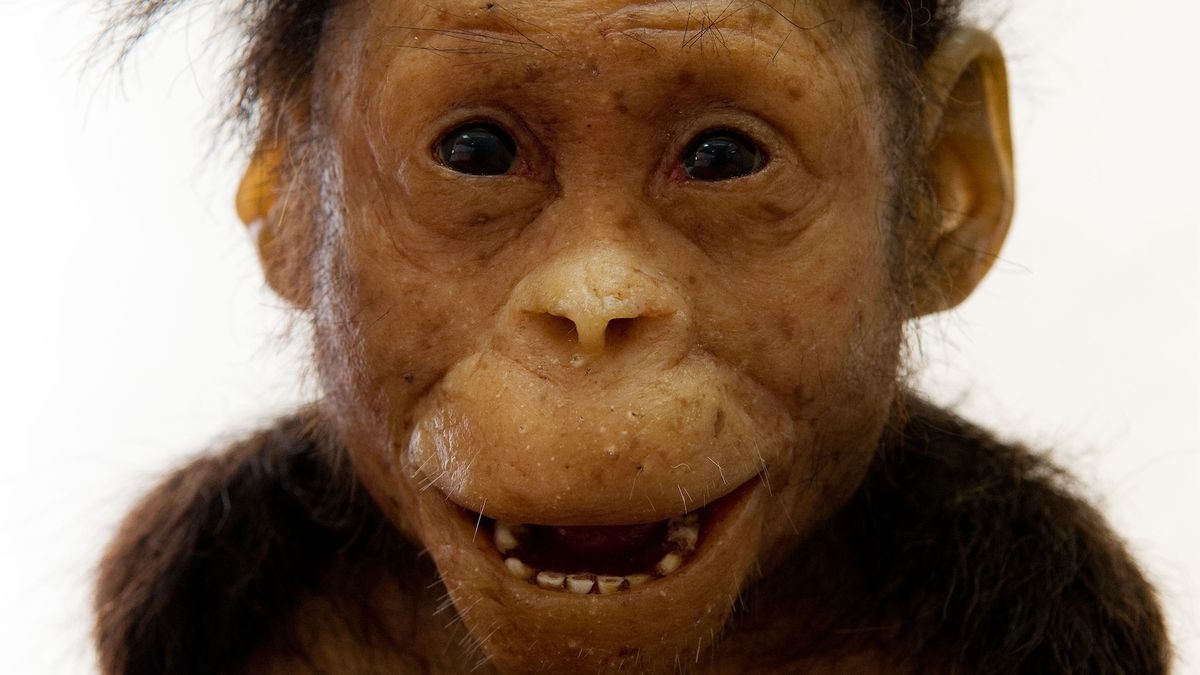Editor’s note: This is part of a special package written for the 50th anniversary of the discovery of a 3.2 million-year-old A. afarensis fossil (AL 288-1), nicknamed “Lucy.”
Our ancestor “Lucy,” a young adult Australopithecus afarensis, became world-famous half a century ago after Donald Johanson and colleagues discovered her remarkably complete skeleton in Ethiopia. Today, Lucy is an important touchstone in human evolution because she lived 3.2 million years ago, evolutionarily halfway between our ape ancestors and us.
But Lucy is just one of many famous hominin fossils. From the “Taung Child” to “the Hobbit,” here are some of the most iconic fossils that have transformed what we know about human evolution and our tangled family tree.
Related: Our mixed-up human family: 8 human relatives that went extinct (and 1 that didn’t)
Australopithecines
The very first australopithecine to be recognized as a bipedal hominin was the Taung Child, discovered by Raymond Dart in South Africa in 1924. He named the fossil Australopithecus africanus, which means “southern ape from Africa.” However, it took nearly 20 years for the scientific community to accept the find, in part because the “missing link” between apes and humans was expected to be found in Asia or Europe, not in Africa. Now, the Taung Child is heralded as one of the most important fossils of the 20th century, as its skeleton helped to prove that bipedalism evolved before a large brain did.
Another complete skull from an adult A. africanus was nicknamed Mrs. Ples after its original genus, Plesianthropus (“near-human”). Mrs. Ples was discovered in 1947, when paleontologist Robert Broom accidentally blasted her skull apart while using dynamite to excavate in the Cradle of Humankind in South Africa. In spite of its inauspicious discovery, after the skull was reassembled, Mrs. Ples became the most complete australopithecine skull ever found, dating back 2.35 million years.
In 1959, an extremely robust australopithecine was discovered by Mary Leakey at Olduvai Gorge in Tanzania. Leakey originally named the skull Zinjanthropus boisei — “Zinj” is an old name for East Africa — and affectionately called him “Dear Boy.” But his massive jaws, as well as teeth four times the size of humans’, led the press to nickname him “Nutcracker Man.”
This discovery proved that there were two kinds of australopithecines — one very robust and one more slender — roaming Africa 2.5 million to 1 million years ago. When this new fossil was reported at a conference, Dart reportedly joked, “What would have happened if Mrs. Ples had met Dear Boy one dark night?”
The Homo genus

Although Lucy is a comprehensive specimen, the most complete individual ever found is that of Nariokotome Boy, a Homo erectus who lived about 1.5 million years ago. Also called Turkana Boy, this youngster, who was 11 or 12 years old when he died, was found in 1984 in Kenya by paleontologist Kamoya Kimeu. Turkana Boy’s anatomy revealed a body type surprisingly close to ours — he may have reached 6 feet (1.85 meters) tall and 150 pounds (68 kilograms) if he had reached adulthood; he had a large brain; and he was fully adapted for efficient walking and running.
While Nariokotome Boy was likely one of our collective ancestors, two divergent branches of our family tree also have famous members: the “Hobbits,” found on the island of Flores in Indonesia, and Homo naledi, from the Rising Star Cave in South Africa.
Skeletons found in a cave in Indonesia in 2004 surprised researchers because of their tiny size and their comparatively recent time frame: 700,000 to 50,000 years ago. At just 3 feet, 6 inches tall (1.06 meters), the members of the newly identified species, Homo floresiensis, were nicknamed “Hobbits,” and one female was named “Flo”. These individuals created stone tools and walked upright, but other parts of their anatomy were more australopithecine-like, similar to Lucy. No clear explanation has been given for why the Hobbits were so small, but one guess is island dwarfism, where large animals evolve to be smaller over many generations when food is scarce.
Related: Lucy’s last day: What the iconic fossil reveals about our ancient ancestor’s last hours
Meanwhile, in South Africa, anthropologists discovered H. naledi deep in the Rising Star Cave system. The most complete individual was nicknamed Neo, which means “gift” in the Sesotho language. Neo was a large adult male, and bones from nearly every part of his body were found. H. naledi had a mix of ancient and modern anatomy — hands that were adapted for climbing and feet that were adapted for walking — that was surprising for a species that lived from 336,000 to 236,000 years ago.
While questions about Flo and Neo abound, some famous fossils are answering long-standing questions about our evolutionary history.
Neanderthals and hybrids
For many years after they were first identified in 1856, scientists thought Neanderthals were unintelligent, cave-dwelling brutes who contributed nothing to modern humans. But the discovery of Denisovans in Russia in 2010 and advances in ancient DNA analysis showed that modern humans, Neanderthals and Denisovans were actually “kissing cousins.”
Bones from a 13-year-old girl nicknamed Denny were found in the Denisova cave and studied in 2018. Denny’s genome showed that she had a Neanderthal mother and a Denisovan father, making her the first — and, to date, only — first-generation hybrid hominin ever discovered. Over the past 15 years, multiple studies have revealed that Neanderthals, Denisovans and Homo sapiens met and mixed many times, but 90,000-year-old Denny remains the poster child for interbreeding between archaic and modern humans.
Although Neanderthals survived for hundreds of thousands of years, they eventually went extinct. “Thorin,” whose skull and teeth were found in France in 2015, may have been one of the last Neanderthals, around 42,000 years ago. Named after a dwarf in J. R. R. Tolkien’s “The Hobbit,” Thorin has provided evidence that Neanderthals died out because they were isolated. When researchers sequenced Thorin’s genome, they found that his ancestors went 50,000 years without exchanging genes with other Neanderthals.
Denny and Thorin have revealed that, although archaic and modern humans did interact for thousands of years, eventually the Denisovans and Neanderthals disappeared as separate populations, although some of their genes live on in humans.


